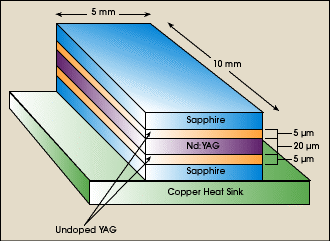Breck Hitz with Daniel S. Burgess
A team of scientists at the University of Southampton in the UK has presented its findings on a diode-pumped Nd:YAG laser fabricated as a planar waveguide. The laser offers advantages in terms of efficiency and a low lasing threshold that suggest such geometries may become commercially competitive with more conventional configurations of diode-pumped solid-state systems.
To understand the configuration of the 10 x 5-mm laser, which was produced by direct bonding at Onyx Optics Inc. of Dublin, Calif., imagine a Fig Newton constructed of YAG and sapphire. Because the 30-µm-thick YAG layer (analogous to the jam filling in the cookie) -- which features a 20-µm-thick active region doped with neodymium and which has a higher refractive index than the sapphire (the cake covering) -- radiation is guided in the core by total internal reflection. The geometry is "planar" because all the surfaces in the stack are perfect planes.
This approach offers several advantages for diode-pumped solid-state lasers. The waveguide confines both the pump and the laser light inside it, so their overlap is especially good, thereby reducing the lasing threshold. The short, wide planar waveguide and the asymmetric beam of a diode pump laser are well-matched, offering efficient coupling.
"The waveguide has the same basic geometry as the high-power diode lasers with which it is pumped," said David P. Shepherd of the research center. "This greatly simplifies the coupling optics required, leading to simple and compact devices."
Moreover, as in a slab laser, the thermal gradients in the planar waveguide laser are in one dimension -- the vertical. They therefore introduce much less distortion than a conventional rod laser experiences, in which the thermal gradients are in two dimensions and in polar coordinates, leading to focusing and birefringence issues.
The double-cladding structure of the waveguide is familiar from its widespread use in high-power fiber lasers. The refractive index of the sapphire is much lower than the index of the YAG, and the interface of the sapphire and the YAG guides the divergent pump radiation. However, unlike in double-clad fibers, the fundamental-mode operation in the laser is attributable to the fact that the neodymium-doped layer at the center of the structure offers a better spatial overlap with the fundamental mode of the multimode YAG/sapphire waveguide, even when highly saturated during high-power operation.

The diode-pumped planar waveguide laser features a bonded stack of sapphire, YAG and Nd:YAG. The geometry of the structure yields benefits in terms of pumping, reduced laser threshold and thermal effects.
To confirm the benefits of the approach, the researchers analyzed the performance of the laser at four transitions, which they selected by tailoring the reflectance of the output coupling mirror on one of the faces of the structure. At the 1064-nm wavelength, the laser generated 4.3 W of output from 9.7 W of pump power, with a slope efficiency of 58 percent. For the quasi-three-level, 946-nm line, they observed an output of 3.5 W and an M2 value of less than 1.3. They emphasized that these results were obtained with passive cooling of the Nd:YAG laser by affixing it to a copper block, whereas earlier, similar experiments required active cooling.
Shepherd said that they next plan to investigate side-pumping the lasers. Pump powers of more than 300 W/cm of the waveguide should be possible with this configuration."We believe that these guides are compatible with side-pumping by multibar diode stacks and are very attractive for compact high-average-power sources of more than 100 W in either CW or high-repetition-rate Q-switched modes of operation." Potential applications include materials processing and marking.